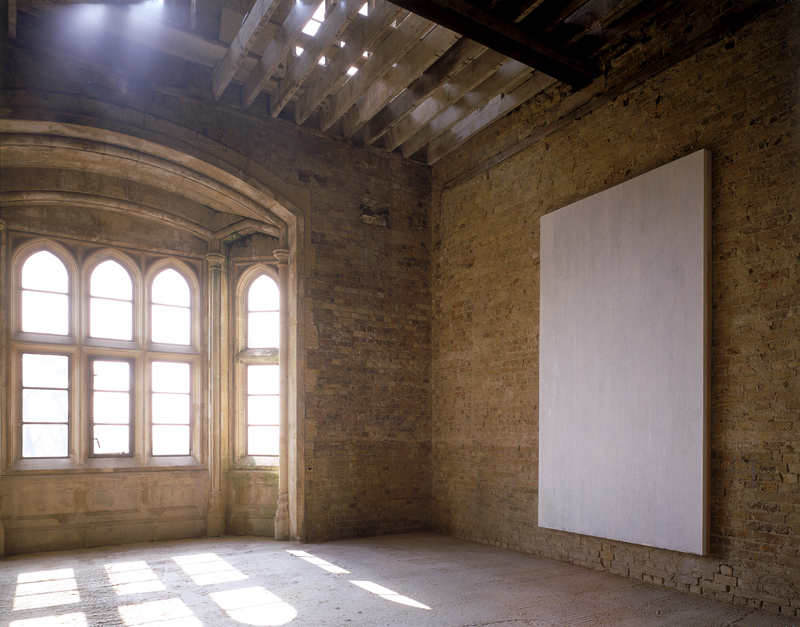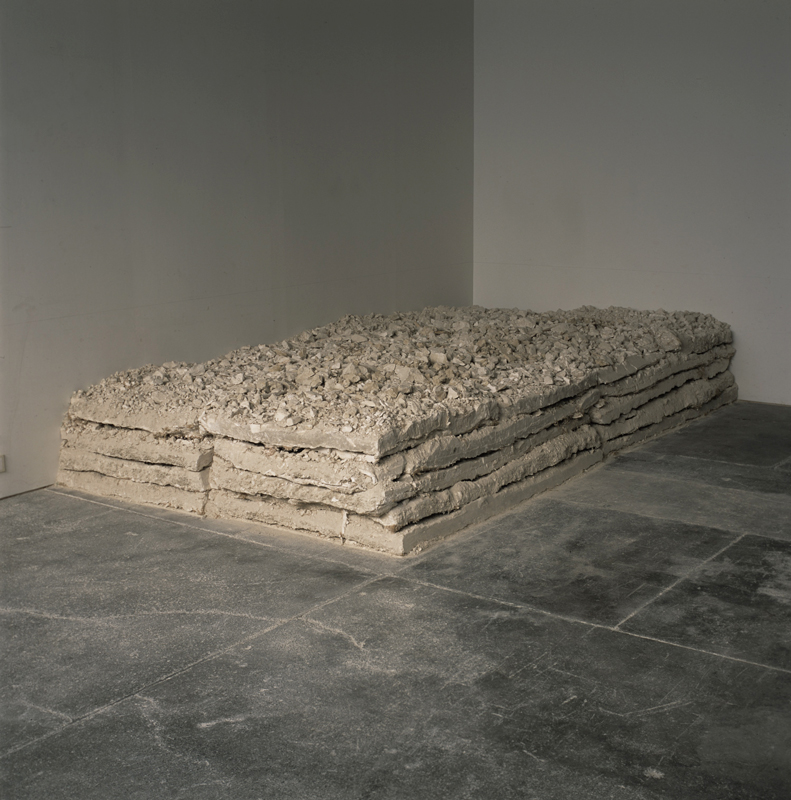Trench 10 - Segsbury Project
Trench 10 is a seminal work created by Simon Callery in collaboration with archaeologists working on the excavations of Alfred’s Castle in the UK. The original, archaeological, Trench 10 was a 20-meter long and 2-meter wide excavation trench cut by archaeologists to expose a section of a Bronze Age ring ditch located outside the ramparts of the hill fort at Alfred’s Castle. After the archaeologists had finished their excavation, Callery and his team poured white, liquid, fine casting plaster in 2 x 1 meter sections over the entire chalk surface of the trench. They then secured the sections of the casts with jute webbing and wooden braces before covering the work with polythene and leaving it for two weeks to cure. Next, the team lifted the sections and transported them to Callery’s studio in London where the 24 plaster panels were left to dry completely.
Callery’s strategy to display the work was to reassemble each panel cast as it was originally in the ground, and then to tip the resulting structure 90-degrees so that it would stand upright. As Callery put it: “My motivation was to find a way to bring the chalk surface as close as possible to the viewer and to set up the possibility of an equally balanced visual and physical encounter.”
The final work was installed in April 2003 in the Officer’s Mess in the grounds of Dover Castle. There, the reconstituted ditch sections were exhibited along with the archive of photographs (presented in plan chests) that Callery had made in 1996 in collaboration with Andrew Watson: 378 black-and-white images taken from a vertical perspective of a 20 x 40 meter trench excavated at Segsbury Camp. Also included in the Office’s Mess exhibition were three of Callery’s paintings (Flake White Entasis - 2001; Porch - 2003; Fabrik - 2000), plan and section drawings, maps, artifact drawings from the excavation, and aerial photographs. Trench 10 was shown later that year at the Storey Institute (Lancaster), and then reconfigured as T10 Reconfigured in 2006 at Rachmaninoff’s art gallery (London), and then as English History 2000-2007 at the University of the Arts London, Wimbledon College in 2007 as part of the Pit Paintings: Thames Gateway Project exhibition.
Further details of the process of work and its exhibition will be found in the following text (upon which the description above and the quotation above from Callery come):
Callery, S. 2014. The story of Trench 10. In C. Gosden and G. Lock (eds) Histories in the Making: Excavations at Alfred’s Castle 1998-2000, pp. 123-45. Oxford: Institute of Archaeology.
For more information about Callery’s work at the Segsbury Project see the following:
Bonaventura, P., Chevalier, T., Archer, M. and Miles, D. 2003. Segsbury Project: Simon Callery. London: English Heritage.
Bonaventura, P. 2011. Communicating in the present tense: an interview with Simon Callery. In P. Bonaventura and A. Jones (eds) Sculpture and Archaeology, pp. 197-214. Burlington, VT: Ashgate.
Callery, S. 2004. Segsbury Project: art from excavation. In C. Renfrew, C. Gosden and E. DeMarrais (eds) Substance, Memory, Display: Archaeology and Art, pp. 63-78. Cambridge: McDonald Institute for Archaeological Research.
Cameron, S.C. 2004. Art from Archaeology: Simon Callery’s Segsbury Project in Cross-disciplinary Context. Unpublished Master’s Thesis, Department of Archaeology, Cambridge University.
Full information about the archaeology of Segsbury Camp will be found in this volume:
Lock, G. Gosden, C. and Daly, P. 2005. Segsbury Camp. Oxford: Institute of Archaeology, University of Oxford.
Simon Callery wishes to acknowledge the support of the following:
Paul Bonaventura, Senior Research Fellow at the Ruskin School of Drawing and Fine Art, University of Oxford. Prof Gary Lock and Prof Chris Gosden, Institute of Archaeology, University of Oxford. David Thorp, Curator and Charu Valllabhbhai of The Henry Moore Foundation Contemporary Projects. David Miles, Chief Archaeologist and Miriam Levin, Exhibitions Manager, English Heritage. Keith Blaxhall, National Trust. Kabir Hussain, Michael Boffey, AB Foundry, Phillip Brown and Alex Dexter. Arts and Humanities Research Council. Mark Fairnington. University of the Arts London, Wimbledon College. Maggie Smith, Matthew Arnatt, Rachmaninoff’s. John Angus, Storey Gallery.
Trench 10 fully excavated. 2000.
Trench 10 artwork process. 2000.
Trench 10 artwork process. 2000.
Trench 10 detail (2003)
Fabrik (2000)
Flake White Entasis (2001)
Segsbury Project - Plan Chest
Segsbury Project - Plan Chest (detail)
T10 - Reconfigured (2006)
English History (2007)










